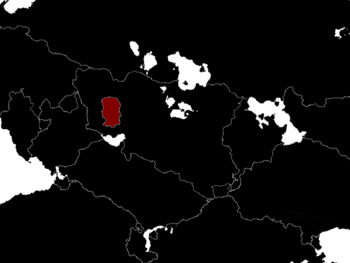Murmusa
The Socialist Republic of Murmusa Социјалистичка Република Мурмуса | |
|---|---|
|
Flag | |
| Motto: Умираме како стоиме (Narendian: We die standing) | |
 Murmusa in Northwest Meridon | |
| Capital and Largest City | Belakarpa |
| Official languages | Narendian |
| Ethnic groups |
|
| Demonym(s) | Murmusan, Murmusans |
| Government | Single Party State |
• General Director | Valentin Mladenovski |
• Chief of the Army | Zoran Klimentina Pandev |
• Autark | Slobodan Grozdana Ivanovski |
| Legislature | Directorate |
| Establishment | |
• Independence from Göke | 18th of November, 1928 |
• Establishment of the Triumvirate | 8th of April, 1984 |
| Area | |
• | 46,082 km2 (17,792 sq mi) |
| Population | |
• 2019 estimate | 6,708,432 (18) |
• 2012 census | 6,692,221 |
• Density | 145.576/km2 (377.0/sq mi) |
| GDP (nominal) | 2019 estimate |
• Total | $45,395,959,344 NSD |
• Per capita | $6,767 NSD |
| Currency | Suveren |
| Date format | dd-mm-yyy |
| Driving side | right |
| Internet TLD | .ma |
This article is incomplete because it is pending further input from participants, or it is a work-in-progress by one author. Please comment on this article's talk page to share your input, comments and questions. Note: To contribute to this article, you may need to seek help from the author(s) of this page. |
The Socialist Republic of Murmusa (Narendian: Социјалистичка Република Мурмуса) is a one party state located on the Murmus Plateau in Northwestern Meridon, and a Narendian ethnic exclave, and with heavily restricted migration to and from the nation, largely imposed by its neighbor Göke. The Murmusan state, since the end of the 1978-1982 Gökan invasion, and the 1983 Coup of the Triumvirs, the Murmusan state has become increasingly authoritarian in nature; with the state authorities intensely marshaling resources for the defense of Murmusa from invasion.
Humans would arrive on the plateau of Murmus shortly after the arrival of modern humans to the Gökan Plateau, roughly 9,800 years ago, primarily as nomadic herders in transit through the plateau to other, more evidently areas. No permanent settlements would exist on the plateau until the mid-900s when proto-Narendian prospectors began to form small mining towns on the mineral rich Murmus plateau. These towns were initially small, with limited access to food being a significant factor in slowing their growth and spread. However, by the 1300s, settlements became more widespread as miners encountered a massive underground aquifer;
Etymology
The term Murmusa is a permutation of a term used in ancient Kumurz to describe the plateau that is the defining geographic feature of the nation, the term Mumus meant high plain in the langauge; but was itterated into Murmus over time and contact with Proto-Narendians; with the term Murmusa (literally land of the high plain) being coined by Narendian ethnonationalists in Murmusa in the mid 19th century. The demonym for citizens of Murmusa is Murmusan or Murmusans.
History
Geography
Demographics
Largest cities or towns in Murmusa
2015 Census | |||||||||
|---|---|---|---|---|---|---|---|---|---|
| Rank | Division | Pop. | Rank | Division | Pop. | ||||
Belakarpa  Vilkbreg |
1 | Belakarpa | Južen | 1,301,250 | 11 | Shishevo | Južen | 110,410 |  Pekol Balka  Strana |
| 2 | Vilkbreg | Istok | 752,125 | 12 | Dolna Matka | Južen | 71,612 | ||
| 3 | Pekol Balka | Centralno | 746,812 | 13 | Arnakija | Centralno | 58,710 | ||
| 4 | Strana | Južen | 742,941 | 14 | Semenishte | Severno | 52,101 | ||
| 5 | Volkovo | Centralno | 485,124 | 15 | Chajlane | Zapaden | 41,750 | ||
| 6 | Badovsti | Severno | 262,181 | 16 | Bukovikij | Centralno | 40,885 | ||
| 7 | Severtočka | Severno | 251,810 | 17 | Rashche | Južen | 40,486 | ||
| 8 | Krushopek | Centralno | 249,110 | 18 | Gornjane | Istok | 40,399 | ||
| 9 | Vodno | Zapaden | 240,850 | 19 | Pobozhje | Estmar | 36,288 | ||
| 10 | Grchec | Istok | 142,110 | 20 | Brodets | Taranar | 35,213 | ||
Government
Economy
Economic Indicators
| Monetary Unit: Suveren (Су)
Conversion Rate: Cy1 = $.02 NSD Fiscal Year: Calendar Year Nominal GDP: $45,395,959,344 NSD GDP per Capita: $6,767 NSD Labor Force: 5,031,324 Unemployment: Records of unemployment not publically available |
|---|
